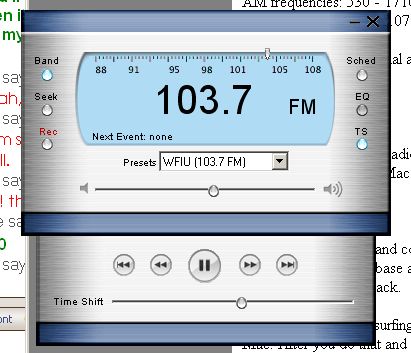

- #RADIOSHARK LINUX HOW TO#
- #RADIOSHARK LINUX FOR MAC#
- #RADIOSHARK LINUX INSTALL#
- #RADIOSHARK LINUX FULL#
Tuning in should be as easy as connecting to your home network via Wifi and inputting the full URL into your player.i.e. In this case, the stream is formatted as ogg-vorbis-and presented as a SHOUTcast stream-not every player can natively play this kind of stream. In my case, I used the excellent, free TCPMP (The Core Pocket Media Player.Windows versions of this great A/V player are also available) running on my Windows Mobile device, as I find it plays almost any type of media. You could allow incoming connections to port 8000, for example, but you should consult security documentation thoroughly to understand the risks of exposing any home computers to outside users in this manner. I simply set it to allow clients on my home network (192.168.1.0 private network address), but a more involved configuration is required if you use, for instance, NAT (network address translation) to protect your internal addresses and wish the streams to be allowed across the internet. If you run the built-in Ubuntu firewall (iptables), you can use "firestarter" GUI to tweak it to allow it to allow local traffic easily, otherwise your clients will likely not see the stream. Properly configuring firewalls in Linux is well beyond the scope of this writeup, especially to protect resources on the internet. It could work similarly on a front-facing internet server, but I do not include the specific steps to do this. NOTE: In this example, I provide a simple way to stream music on your home network. Step 6: Allow Clients to access your streaming server Step 5: Check that icecast/darkice is presenting your stream by navigating to your server's address using Firefox: You can also monitor your streams/listeners here. You could also simply initialize the icecast service on startup, run your script, or use cron to execute your scripts at preset times to play, stream or record when you like. In my case, I tweaked the earlier posted FMstart script and launcher shortcut to include the streaming commands instead. $ sudo /usr/bin/darkice -c /etc/darkice.cfg In the terminal console enter the following commands (or add a bash script that does this): Step 4: Tune the radio shark, start icecast2 and darkice. Touch a file into the /etc directory called darkice.cfg, and edit the values for your configuration. You also need to set your actual value to your computer name. It's important to configure all the authentication sections, especially the default passwords that are all set to "hackme". Step 2: Setup icecast.xml (/etc/icecast.xml), by opening in your favorite editor.
#RADIOSHARK LINUX INSTALL#
Select icecast2, and darkice packages and accept all supporting files when Synaptic auto-adds the required files, and then install them.

Step 1: Open Synaptic Manager in Ubuntu and do a search for "icecast" If you just want a quick tutorial on streaming via icecast and darkice in Ubuntu, you could use this as a quick guide, but there's a ton better on the web (i.e. **Updated Mafor iPhone/iPod player e belowįirst, check out the previous 2 posts, here and here, to get the background needed to get RS functional in Ubuntu (at least enough to play). Yeah, cool eh? Stream your favorite local radio station to anywhere on the net. This post will be a little more advanced, in that we will set up Ubuntu to stream the RS output on the web as an audio stream. To learn the basics of getting RS to play and record, see my last 2 posts. In my endeavors to get Ubuntu at least as functional as Windows on my dual-boot laptop, I've included these instructions in case anyone else out there is trying to similarly get all their devices working.

#RADIOSHARK LINUX FOR MAC#
The device was actually designed for MAC and Windows, but some serious Linux users have found ways to make it work with Linux.
#RADIOSHARK LINUX HOW TO#
This is the 3rd installment of a series of tutorials on how to get the Radio Shark to function in Ubuntu Linux. Lately, I've really been geeking out on Ubuntu and a radio tuner device my kids bought me last year called a Radio Shark.


 0 kommentar(er)
0 kommentar(er)
